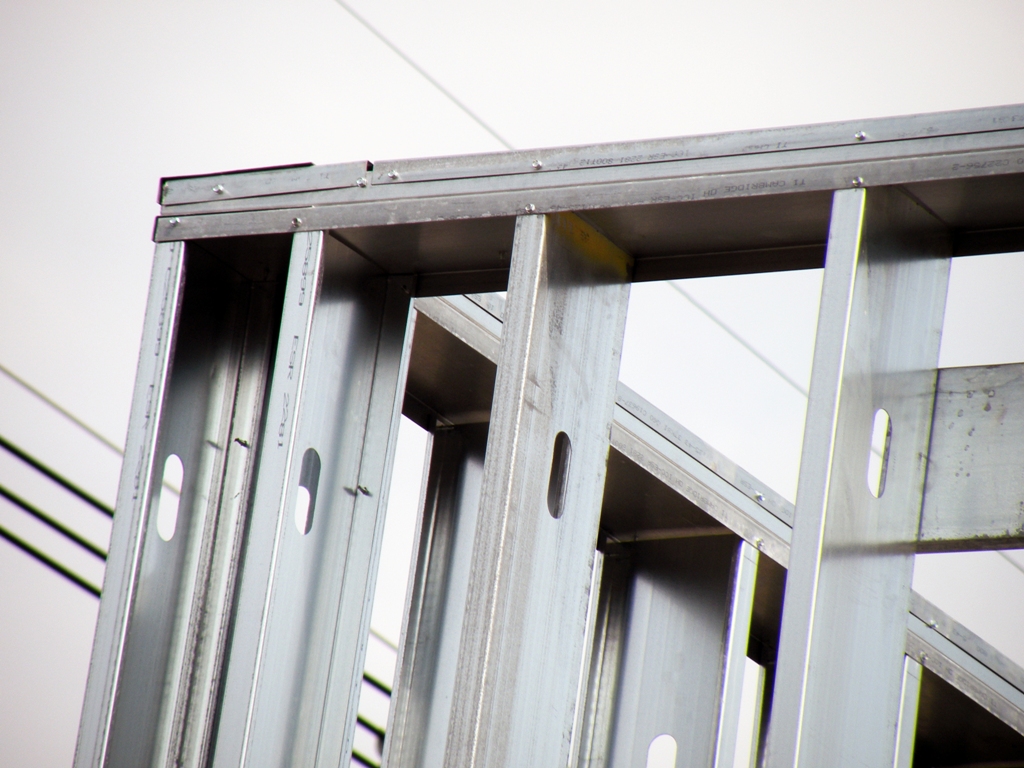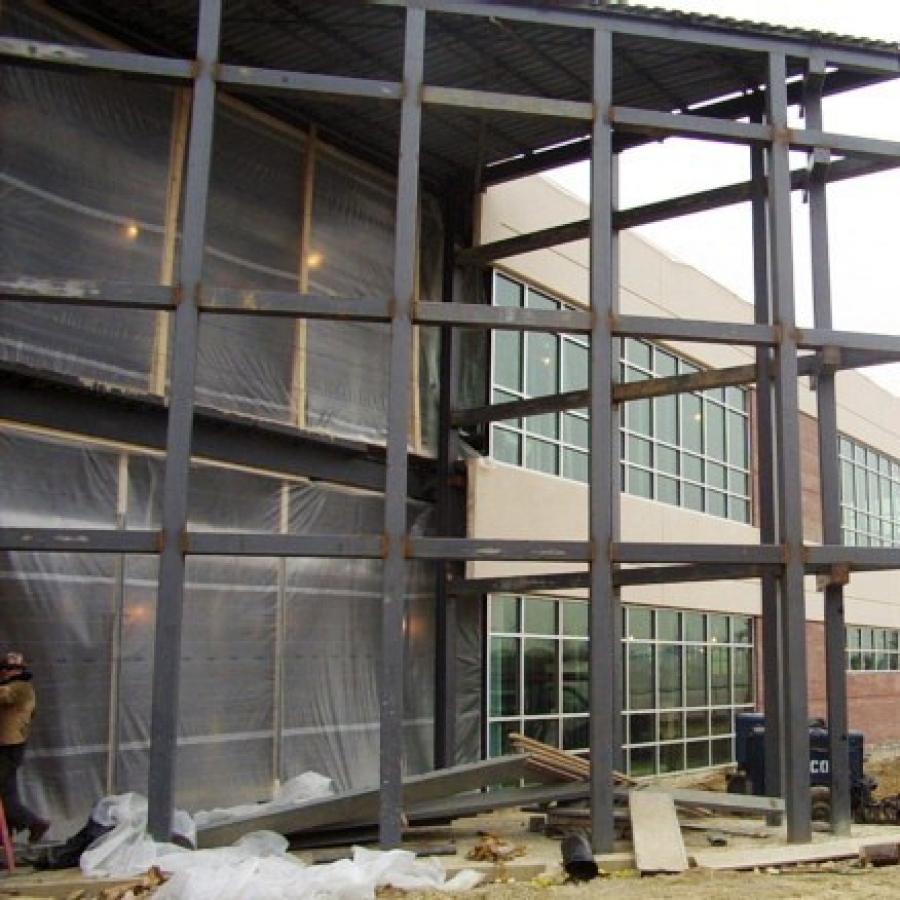Miscellaneous Metals: What Needs to be Reflected in the Design Documents and Why
The need for secondary steel often arises for heavy items mounted on gypsum board walls and ceilings when the stud framing itself is not structurally sufficient to carry the load. Secondary steel in this case is constructed in line with the stud framing to augment its structural capacity. Coiling doors and ceiling mounted toilet partitions are two examples of when secondary (also commonly termed supplemental or miscellaneous) steel will be required behind or above the gypsum board. Coiling door and ceiling mounted toilet partition fasteners will actually bridge though the gypsum board and fasten directly to the concealed secondary steel.

Why Miscellaneous Metals Need to be Included
Like miscellaneous metals, interior stud framing is also traditionally a design-build trade. A common misunderstanding is that secondary steel used to augment stud framing does not need to be depicted in the drawings because miscellaneous metals and stud framing are both design-build trades. Therefore, the contractor should be fully responsible for whatever means necessary to construct an adequate supporting structure. The fact is that this complicated coordination effort between the framing and miscellaneous metals bidders cannot reasonably be completed during the already hectic bidding phase of a project. It is acceptable, and efficient, for the subcontractors to perform all engineering for this work, but the bidders need some way of knowing where secondary steel is necessary during the bidding phase. The most efficient and effective method of conveying this information to the bidders is with a graphic representation of the secondary steel in the design drawings.
Architects may also hold that because stud framing engineering is the contractor’s responsibility, they cannot know prior to receiving the framing shop drawings if the stud framing will or will not be sufficient to carry the various component loads. In practice, experience has shown that there are few circumstances when the necessity for secondary steel is not obvious to a veteran architect. When borderline cases do present themselves a phone call to the structural engineer or a general contractor should resolve any questions.
The steel indicated graphically in the design drawings does not need to be sized or in any way engineered. This steel only needs to be depicted graphically so the bidders are cognizant that it needs to be included in their estimates.
It is true that if secondary steel is not depicted in the design documents the contractor will in fact still have the ability to effectively build the project. The general contractor can identify where secondary steel is necessary during the submittal process and alert the miscellaneous metals subcontractor when secondary steel needs are identified. Unfortunately, the submittal process does not occur until well after bidding is complete and subcontracts have been awarded. Without graphic depictions of the secondary steel in the design documents inaccurate bids will be received.
With few exceptions, secondary steel will be provided by the miscellaneous metals subcontractor and the item which the secondary steel is supporting will be provided by another trade. The entire component being designed must be fully coordinated by the design team and depicted in the design documents. For example, the design for ceiling hung toilet partitions usually consists of a toilet partition specification section and simple lines on the floor plans depicting where the partitions need to be. Section details of toilet partitions are not always provided, which is generally acceptable for all toilet partition types except ceiling hung. Because ceiling hung toilet partitions require secondary steel, the architect is obligated to provide a detail illustrating the above ceiling secondary steel to ensure the design documents are clear for bidding purposes. Miscellaneous metals subcontractors are experts at designing and installing secondary steel, but they are not experts at toilet partition installations. Without this detail, the miscellaneous metals bidders will not realize the specific toilet partitions identified for the project will require secondary steel.
Similarly, the steel for a coiling door may not be shown on the design drawings for any purpose other than informing the bidders of its necessity. This steel will be fully engineered by the miscellaneous metals subcontractor and, because it is fully concealed within the walls, has no architectural impact to the building. Nevertheless, reflecting this steel on the design drawings for the sole purpose of identifying its existence to the bidders is a good enough reason to provide the detail.
What Information Needs to be Included
Now that we have discussed ‘why’ secondary steel needs to be indicated in the design documents, we will discuss ‘what’ information needs to be provided by the design team. In fact, the miscellaneous metals subcontractor only needs to be informed of where secondary steel is necessary and if there are any architectural concerns that will impact its design. The following points will clarify the hazy line that divides the design work of the architect and the design work of the miscellaneous metals subcontractor.
-
As discussed above, the architect must graphically depict all secondary steel. Miscellaneous metals subcontractors understand that this steel will be shown sporadically throughout the architectural drawings and are well accustomed to sorting through all architectural drawings to locate and estimate this steel. Secondary steel does not require any special organization within the architectural drawings, but it does in fact need to be shown in the architectural drawings. The miscellaneous metals bidders cannot be expected to find secondary steel components in civil, plumbing, electrical or other drawing series.
-
The size, shape, configuration and connections of secondary steel in concealed locations (within walls, ceilings, etc.) do not need to be provided in the design documents. In fact, a change order issue may present itself if the architect furnishes too much information. For instance, if the architect calls for 3/16” welds, but the miscellaneous metals subcontractor later realizes through their engineering calculations that 3/8” welds are necessary, a change order request may be justified. The basis of this change order request would be that deceptive information was provided in the design documents.
-
When secondary steel is exposed, its size, shape and configuration do need to be provided by the design team. This is to ensure the design intent of the exposed steel is clearly relayed in the form of design parameters to the miscellaneous metals subcontractor. An example of when the architect will need to identify the size, shape and configuration of steel for aesthetic reasons might be an exterior canopy with exposed steel. In this case the architect will furnish much more information than just identifying the steel shapes. To ensure the canopy meets the design intent they will also size the steel members, show the type of connections to use and provide any other information necessary to eliminate design variables. The architect’s job in this case is to ensure the canopy is engineered by the miscellaneous metals subcontractor to perfectly match their architectural intentions. In this case the architect may show that a connection is to be welded (i.e. not bolted), but they should not identify the size of the weld. In this case the architect may call for a 4” x 4” tube steel member (i.e. not channels or pipe), but they will not indicate the thickness of the tube steel.
-
Secondary steel connections do not need to be engineered by the design team. Quite often when architects are unsure of what does or does not need to be identified in the design documents they will indicate some random welds, bolts sizes, steel thickness and other general information. This type of information is not required of the design team, as the miscellaneous metals subcontractor will just need to engineer it anyway. In fact, if the design team details the connections and the miscellaneous metals subcontractor later determines larger connections are necessary they will have sufficient grounds for requesting additional compensation on the basis of deceptive information being provided in the design documents.
Again, the design team must ensure the design intent and construction type of each building component is clear to the contractor (i.e. provision of a good ‘construction set’ of design documents). They must also ensure that all bidders are clear as to their respective roles on the project (i.e. provision of a good ‘bid set’ of design documents). If these two criteria are met the design team has done their job well.
This article was republished from the book "Developing Effective Construction Documents" by Jason G. Smith.

Jason G. Smith
With an extensive background as a Builder, Jason G. Smith has constructed projects ranging from $10,000 to $400,000,000 throughout his career. During his career with a Top Ten Prime Contractor Jason was promoted quickly through the ranks to the position of Senior Project Manager on multiple high profile projects. Known for his expertise as a Builder, Jason has been welcomed by Architects and Owners alike at the forefront of the design effort bringing expertise in constructability to the team.
Website: contrainorg.com/



